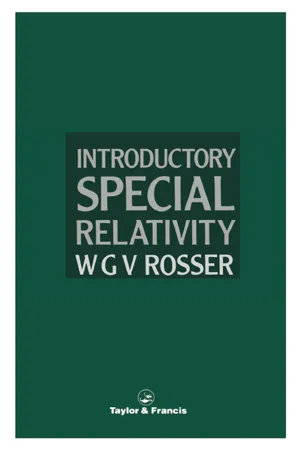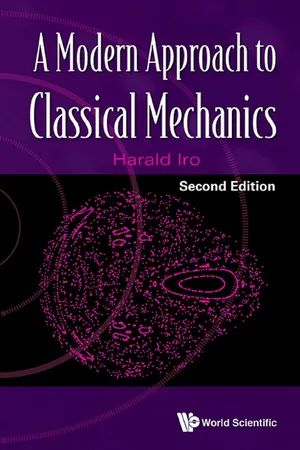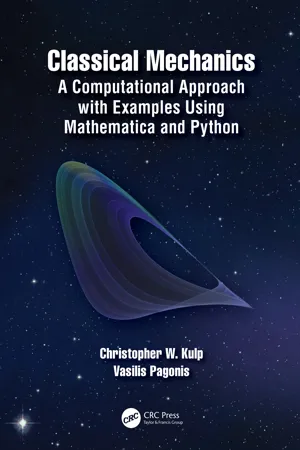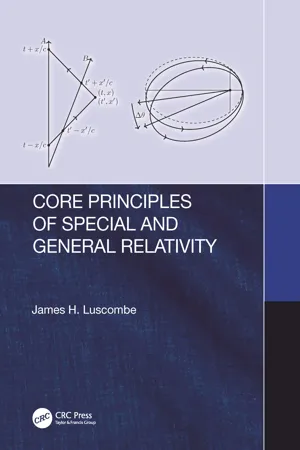Physics
Inertial Frame of Reference
An inertial frame of reference is a coordinate system in which a body at rest remains at rest and a body in uniform motion continues to move in a straight line at a constant speed unless acted upon by an external force. In this frame, Newton's first law of motion holds true, and it is used as a standard for measuring the motion of objects.
Written by Perlego with AI-assistance
Related key terms
Related key terms
1 of 4
Related key terms
1 of 3
7 Key excerpts on "Inertial Frame of Reference"
- eBook - ePub
- W G V Rosser(Author)
- 2017(Publication Date)
- CRC Press(Publisher)
If in a reference frame a particle under the influence of no forces (e.g. a particle far away from any other particles capable of exerting forces) travels in a straight line with constant speed then Newton’s first law (the principle of inertia) is valid in that frame, which is then considered suitable for the application of Newton’s laws of motion. Such a reference frame is called an inertial reference frame, or inertial frame or sometimes a Galilean reference frame. An experimenter at rest in an inertial reference frame is called an inertial observer. The same definition of an inertial reference frame will be used in the theory of special relativity. Owing to the rotation of the Earth, the laboratory frame, that is a reference frame fixed to the Earth, is strictly not an inertial reference frame, and effects associated with the Earth’s rotation are sometimes important. For example, consider a spaceship coasting with uniform velocity relative to the fixed stars. There are no applied forces acting on the spaceship. If its position is plotted on a coordinate system fixed to the Earth then, owing to the Earth’s rotation, the spaceship will appear to travel in a spiral path, going around through 360° every day. According to Newton’s first law, since there are no forces acting on the spaceship, it should travel in a straight line in all inertial reference frames. This shows that the laboratory frame, i.e. a reference frame fixed to the Earth, is not an inertial reference frame, and effects associated with the Earth’s rotation are sometimes important even in terrestrial experiments, such as long-range naval gunnery and Foucault’s pendulum experiment. In these cases we get a better approximation to an inertial reference frame by taking a frame at rest relative to the solar system or the fixed stars - eBook - ePub
- Harald Iro(Author)
- 2015(Publication Date)
- WSPC(Publisher)
4 . The coordinate system is often considered to be the reference frame, but strictly speaking one should distinguish between these two notions. Of course, a change of reference frame is accompanied by a coordinate transformation (but not, in general, vice versa). In a certain sense, one may say that the concept of a reference frame emphasizes the physical world view, while the concept of coordinate systems emphasizes the mathematical point of view.8.1 Inertial frames
In view of the possible dependence of physical laws on the frame of reference, it is natural to ask: given a particular frame of reference, do there exist ‘equivalent’ reference frames, in which a preferred physical law is the same as in that frame?The fundamental law in nonrelativistic mechanics is Newton’s equation of motion for a particle influenced by a force: m = F. In Newton’s first law, free motion, i.e. F = 0, is selected as the basic case, relative to which – by the second law – the presence of forces can be assessed. Thus the distinguished role of uniform and rectilinear motion is established. In former times the view was advanced that every motion needs a cause. Also to maintain free motion of a body there has to be a permanent push. Later on, instead of this view, free motion was explained by the property of inertia5 of a body.Returning to the question of reference frames: Indeed, an important class of reference frames is selected by the requirement that in each of the frames, motion – in the absence of a force – obeys the equationIn each frame free motion is uniform and rectilinear. Such frames are called inertial frames. In 1886, L. Lange proposed6 - eBook - ePub
- Michael M. Mansfield, Colm O'Sullivan(Authors)
- 2020(Publication Date)
- Wiley(Publisher)
transformation.Inertial reference frames
An inertial reference frame is a frame in which Newton's first law of motion holds. In such a frame, any body which is in a state of rest or of uniform motion (that is, constant velocity, which may be translational, rotational or both) continues in that state without change of translational or angular velocity. Thus we see that Newton's first law provides a practical test of whether Newton's second law applies. We can therefore state thatIt follows that the general conservation principles (of momentum, angular momentum, and energy) also apply in inertial frames because they are derived directly from Newton's laws.Newton's second law of motion applies only in inertial reference frames.8.2 The Galilean transformation
A common practical requirement is the conversion of the coordinates of a point, as measured in one reference frame, to the coordinates of the same point, as measured in a second reference frame which is moving with constant velocity relative to the first. The equations which are used to achieve this conversion are known as the Galilean transformation (Galileo Galilei,1564–1642) and are derived below.(a) The coordinates of a point P in the x—y plane as viewed from a fixed reference frame K (coordinate system (x, y)) and from a frame K′ (coordinate system (x′, y′)) which is moving with velocity v along the x‐axis of the fixed system. (b) The Galilean displacement transformation of the displacement of P from the moving system to the fixed system, namelyFigure 8.3r = r′ + vt.Consider the two reference frames, K and K′ (Cartesian coordinate systems), as illustrated in Figure 8.3 . The second frame, which has axes x′, y′ and z′, is moving so that its origin, O′, is moving at constant velocity, v, along the x‐axis of the first frame, which has axes x, y and z. The x′‐axis of the second frame lies along the x‐axis of the first frame. If the coordinates of an event are (x, y, z, t) and (x′, y′, z′, t′), respectively, in the two frames and if the origins of the two frames, O and O′, coincide att = t′ = 0, we can, by inspecting Figure 8.3 - eBook - ePub
Classical Mechanics
A Computational Approach with Examples Using Mathematica and Python
- Christopher W. Kulp, Vasilis Pagonis(Authors)
- 2020(Publication Date)
- CRC Press(Publisher)
CHAPTER 10Motion in Noninertial Reference FramesAs we saw in Chapter 1 , Newton’s second law is valid only for inertial reference frames. However, it is sometimes the case where we need to describe the motion in a noninertial reference frame. For example, long-range missile trajectories need to be described using a noninertial reference frame, a frame fixed to the surface of the rotating (and therefore noninertial) Earth. In Chapter 1 we found that using Newton’s second law in a noninertial reference frame, resulted in the appearance of inertial forces. In this chapter, we will expand on the idea of inertial forces; specifically, those arising in rotating reference frames. We will discuss how a vector in a rotating reference frame can be described in a nonrotating frame, and from that description, show how applying Newton’s second law in a rotating frame results in inertial forces such as the Coriolis force and the centrifugal force. We will then study how the Coriolis and centrifugal forces affect the motion of a particle near the surface of the Earth. Finally, we will explore the famous problem of the Foucault pendulum and projectile motion in a noninertial frame.10.1Motion in a nonrotating accelerating reference frameAlthough we examined the case of a nonrotating accelerating frame in Chapter 1 , it is worthwhile revisiting it, this time using three dimensions. Consider a particle of mass m whose motion is being described using two reference frames as shown in Figure 10.1 .Figure 10.1: A particle of mass m located at a position r′ relative to the origin of an inertial frame S′ and at a location r relative to the origin of a noninertial frame S. The vector R measures the position of the noninertial frame’s origin relative to the origin of the inertial frame.The reference frame S′ shown in Figure 10.1 is an inertial frame which we’ll imagine to be at rest, and the frame S is accelerating away from S′ with an accelerationA =. In Chapter 1 , we denoted the moving frame with primes. In this chapter, we will switch our notation for convenience and use primed variables to describe quantities measured in the inertial frame S′ and unprimed variables for quantities measured in the noninertial frame SR ¨ - eBook - ePub
- Serhii Stepanov(Author)
- 2018(Publication Date)
- De Gruyter(Publisher)
6 Non-inertial frames This chapter concerns non-inertial reference frames. First, we will study rigid, uniformly accelerating frames and show that the rate of their time flow depends on the relative positions of observers. We will then consider the physics of a rotating disc. The most unusual property of such a frame is the impossibility of synchronizing clocks along certain closed curves, despite the fact that all of their points experience a common flow of time. The third example of a “non-rigid” frame will give the general definition of a reference frame. In conclusion, we will consider some “paradoxes” related to non-inertial frames. The idea of non-inertial frames will be considered again in chapter 9, from a more general mathematical point of view. 6.1 Uniformly accelerating frames Consider a frame S : { t, x }. Let the point with coordinate x = 0 in it move with a constant proper acceleration a = c o n s t relative to the inertial (laboratory) frame S 0 : { T, X }. We assume that the axes labeled x and X are parallel to each other and have the same direction. The trajectory of a uniformly accelerated relativistic particle (p. 85) has the form: X (T) = 1 a [ 1 + (a T) 2 − 1 ]. (6.1) The particle is at rest at T = 0, and then starts moving with increasing velocity (but decreasing acceleration): U (T) = d X d T = a T 1 + (a T) 2. (6.2) Let the origin of the frame S (and the observer at this point) move relative to S 0 according to equation (6.1) : Space is not isotropic inside the non-inertial frame S. More precisely, it is isotropic inside the (y, z)-plane normal to the acceleration, but not isotropic along the x -axis. In particular, free particles will not undergo uniform linear motion. We will assume that the proper acceleration a is small, although the velocity U of the frame S relative to S 0 can be large. This means that the observer at the origin of S can neglect, at least locally, the anisotropy of space with respect to their standards of length - James Luscombe(Author)
- 2018(Publication Date)
- CRC Press(Publisher)
evolves in response to matter. The version of Newton’s first law that survives to GR is that free particles follow geodesic paths in spacetime, those determined by the distribution of energy-momentum. We return to this idea when we take up GR.3.What’s constant speed ? For speed, we need time . But whose time? Newtonian mechanics utilizes an absolute time that pervades the universe—see page 8. In relativity, time and space do not have separate existences and are reference-frame specific .1.2.3Equivalence of inertial reference framesOnce a frame has been found meeting the criteria for an IRF, any other frame moving relative to it with constant velocity also constitutes an IRF.23 A natural equivalence among IRFs is established by free particles : All inertial observers agree that the trajectories of free particles are described by constant velocity; all agree on the law of inertia. The value of the speed is reference-frame specific, but all agree on its constancy. Thus, all inertial observers agree on the laws of mechanics: Forces manifest in changes of states of inertial motion. Different inertial observers can observe the same phenomena and describe them by the same laws . Transforming from one set of inertial observers to another does not change the laws—the very heart of the principle of relativity.1.2.4Coordinate transformations and the principle of covarianceTransformation is central to relativity. Transformations between reference frames are effected mathematically as transformations among the different coordinates assigned to the same event by all the different, yet equivalent inertial observers. An event is a point in space at a point in time. Anything that happens, or has happened or will happen, comprises an event. The totality of all events is a four-dimensional continuum referred to as spacetime (no hyphen). We require that the mathematical form of the laws of physics be unaffected by changes in reference frames, changes in the coordinates assigned to events , a theme that accompanies us from Newtonian mechanics to SR to GR, that the laws of physics be expressed in a way that their form is invariant under progressively more general coordinate transformations. Form invariance of physical laws is called the principle of covariance- eBook - ePub
- Catherine Wilson(Author)
- 2017(Publication Date)
- Routledge(Publisher)
Here there is no question of an infinite class of equivalent frames, each adequate to the coordinatization of the whole infinite space, and one of which is privileged as absolute. Rather, Newton is asking us to envisage one fixed, immobile reference space, through which various bodies are moving, and along with them, certain delimited spaces defined with respect to them. A relative space is thus a delimited region of space, rather than an infinite frame, and is determined by the situation or position of surrounding bodies, which are themselves situated in immobile, absolute space.This rendering leads to a reconsideration of what Newton says about the relativity of motion. For if relative spaces are not reference frames, how could Newton have anticipated the Galilean relativity we recognize in his mechanics today? I shall argue that careful attention to his words shows that he did not, and that this is a consequence of the fact that he did not have a modern ‘Newtonian’ conception of the relationship between force and motion.For, despite his commitment to the principle of rectilinear inertia, Newton consistently held in his early writings on dynamics that force is necessary to produce motion, and only gradually and incompletely emancipated himself from this conception. To a modern ear, this sounds like a contradiction, since inertial motion is motion that takes place in the absence of any forces. But Newton did not initially abide by this Cartesian conception. In the (untitled and unpublished) anti-Cartesian polemic he wrote prior to the Principia (in about 1669, or possibly later), now usually known by its opening words ‘De Gravitatione’,4 inertia is a force:Def 8. Inertia is the internal force of a body preventing its state from being easily changed when an external force is introduced. (Hall and Hall [1962]. pp. 114. 148)This is further clarified by Definition 5 on the same page:Def 5. Force is the causal principle of motion and rest. And it is either an external one which generates or destroys, or at least in some way changes, the motion impressed in a body; or it is an internal principle by which motion or rest imparted5
Index pages curate the most relevant extracts from our library of academic textbooks. They’ve been created using an in-house natural language model (NLM), each adding context and meaning to key research topics.
Explore more topic indexes
Explore more topic indexes
1 of 6
Explore more topic indexes
1 of 4






